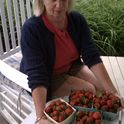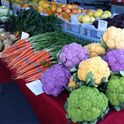What are your favorite green bean varieties to grow? I'm interested in something that tastes great fresh/uncooked
8 Comments
mainecook61June 16, 2016
Fortex. It's a long dangly delicious green pole bean. Johnnys Selected Seeds and Fedco have it.
scruzJune 16, 2016
i used to grow shopping bags full of favas and would give them to local restaurants in my town. i love the look and smell of them. but, i grew italian flat beans for cooking, which are still my favorites. but for something raw, try chinese snap peas. i used to go through the garden picking this and that and wrapping them in leaf lettuces and make my green "tacos." snap peas require posts and netting for them to grow up and mine were really prolific.
702551June 15, 2016
It's worth pointing out that eating even moderate quantities of raw beans can be harmful for your health. The beans contain lectin phytohaemagglutinin, a naturally occurring toxin that is neutralized by cooking.
This chemical compound is found in higher quantities in red kidney beans and white beans like cannellini, and in smaller doses in green beans and some broad beans (favas included).
This toxicity affects a wide range of monogastric (single stomach) mammals, not just humans. Ruminants (mammals with multi-chambered stomachs) have the proper digestive system as to not be affected by this toxin.
Caveat emptor for those who eat beans and peas uncooked.
This chemical compound is found in higher quantities in red kidney beans and white beans like cannellini, and in smaller doses in green beans and some broad beans (favas included).
This toxicity affects a wide range of monogastric (single stomach) mammals, not just humans. Ruminants (mammals with multi-chambered stomachs) have the proper digestive system as to not be affected by this toxin.
Caveat emptor for those who eat beans and peas uncooked.
Barb S.June 15, 2016
Yes, I only eat one or two samples of raw beans to check on whether to harvest. I really prefer them cooked and pickled. I love the Blue Lake beans. I've converted my English (heritage) boyfriend to them. He grew up eating sliced (Frenched), cooked Scarlet Runner beans, and he thinks Blue Lake are far superior. We live in British Columbia's Lower Mainland, which is the south-western bottom corner of BC. Cheers!
SMSFJune 15, 2016
Blue Lake green beans get my vote. I love them uncooked and also pickled.
ValhallaJune 15, 2016
While I have been known to pop raw English peas into my mouth as I pick them, the only ones I like truly raw in quantity are sugar snaps, which are great sliced in salads.
702551June 15, 2016
First of all, I suggest you talk to the folks at your local nursery. There are hundreds (likely thousands) of cultivars of beans and some will grow better in your region than others. This is a general rule of thumb for any plant, not just food crops. You don't list your location, so no one here can make specific suggestions.
I don't eat uncooked beans so I can't address that part of your question. Blue lake beans grow well in the SF Bay Area, as do favas, sugar snaps, English peas, snow peas, all of which I prefer fresh. I'd plant maybe one yellow wax bean, I like the color contrast, even though I like the blue lakes better. I don't care much for the thin filet beans (haricots verts) despite the fact that they also grow pretty well here.
That's what I did when I had a garden (my current place does not).
I don't eat uncooked beans so I can't address that part of your question. Blue lake beans grow well in the SF Bay Area, as do favas, sugar snaps, English peas, snow peas, all of which I prefer fresh. I'd plant maybe one yellow wax bean, I like the color contrast, even though I like the blue lakes better. I don't care much for the thin filet beans (haricots verts) despite the fact that they also grow pretty well here.
That's what I did when I had a garden (my current place does not).
702551June 15, 2016
Another suggestion is for you to visit your local farmers market. Those people are growing things that do well in your local region's climate and soil. For sure, many of them are growing cultivars that are suited as a commercial crop (high yield, pest resistance, quick growing season), but that gives you to opportunity to taste and decide what you like.
From that point, then it's back to the nursery to see if there are related cultivars that might be more appealing to you, the home gardener (like better flavor at the expense of high yield).
I've been eating peas and beans for a really long time, I have some pretty good ideas of what I like. Going to the farmers market every week has given me a pretty good understanding of what grows well in my region.
I'd still have to consult with the nurseries, the SF Bay Area has a very wide range of microclimates. It can be cool (low 60s) and foggy by the ocean, sunny (high 90s) and clear 10-30 miles inland. There's a community garden within a 3 minute walk of my place. I'd probably ask those people as well.
In many ways, it would be more useful for you to ask your neighbors rather than an anonymous bboard on the Internet as this question is highly tied to your specific microclimate, terrain and soil.
Anyhow, good luck.
From that point, then it's back to the nursery to see if there are related cultivars that might be more appealing to you, the home gardener (like better flavor at the expense of high yield).
I've been eating peas and beans for a really long time, I have some pretty good ideas of what I like. Going to the farmers market every week has given me a pretty good understanding of what grows well in my region.
I'd still have to consult with the nurseries, the SF Bay Area has a very wide range of microclimates. It can be cool (low 60s) and foggy by the ocean, sunny (high 90s) and clear 10-30 miles inland. There's a community garden within a 3 minute walk of my place. I'd probably ask those people as well.
In many ways, it would be more useful for you to ask your neighbors rather than an anonymous bboard on the Internet as this question is highly tied to your specific microclimate, terrain and soil.
Anyhow, good luck.
Showing 8 out of 8 Comments
Recommended by Food52
Popular on Food52
Continue After Advertisement


